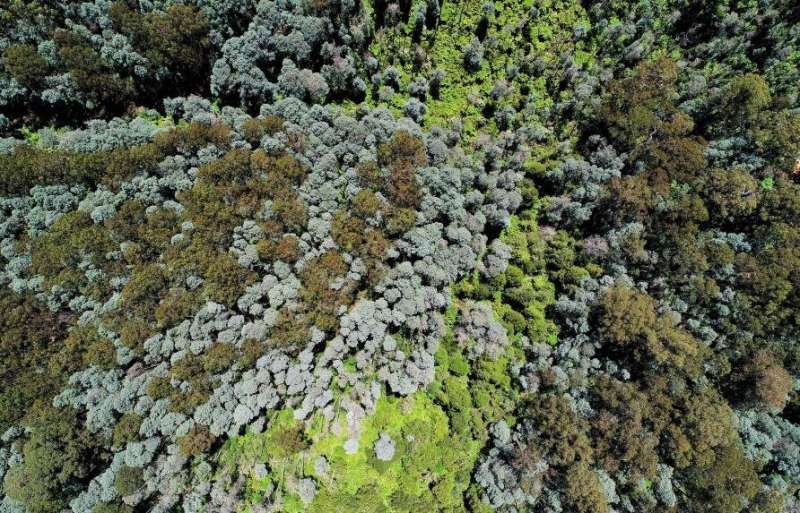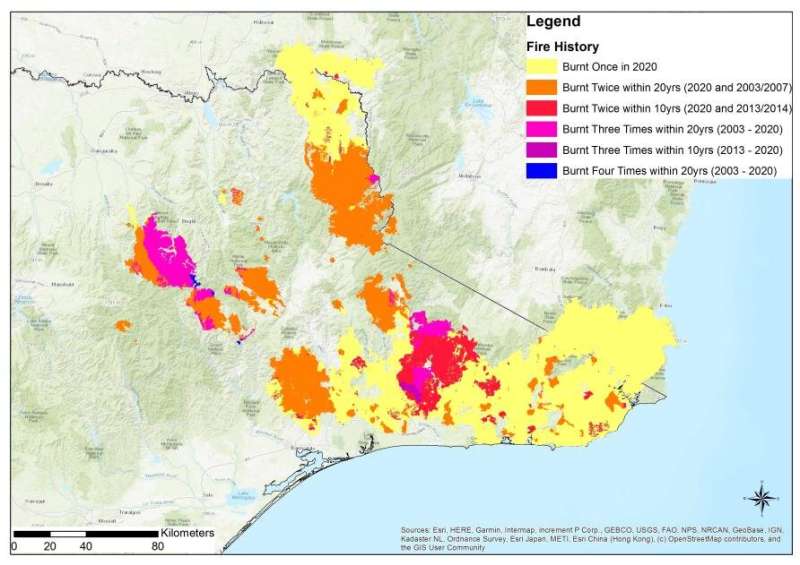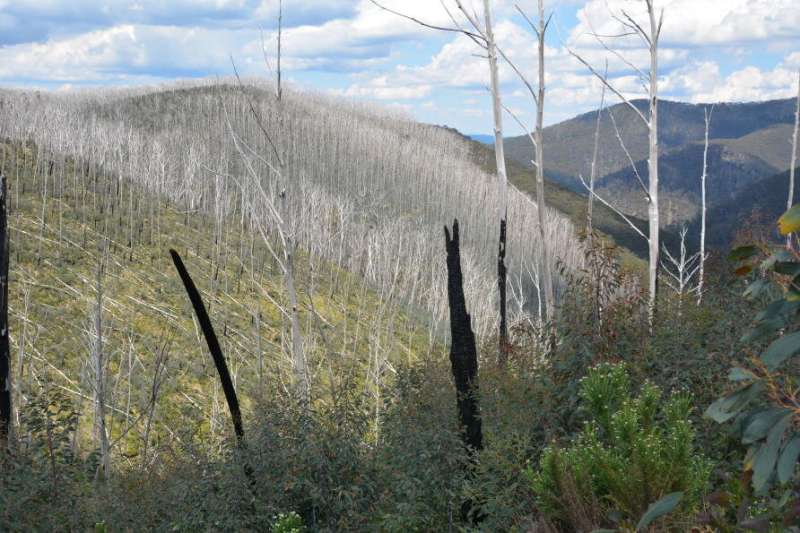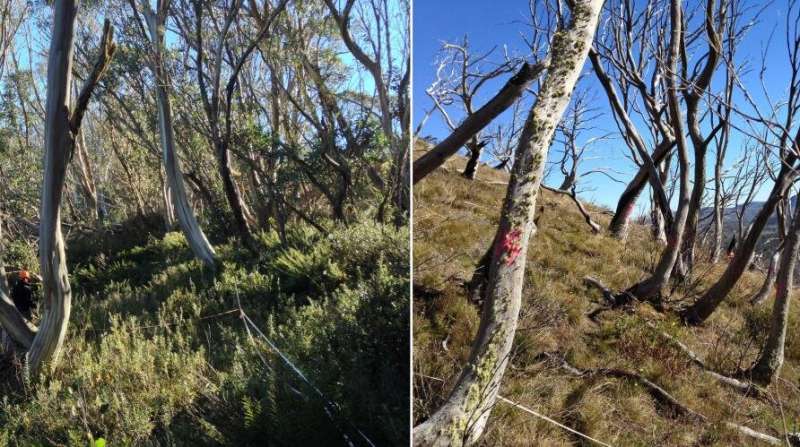A range of tree species dominate the forests of East Gippsland. Credit: Benjamin Wagner/University of Melbourne
Blackened tree stems are all that remain in many post-fire images of eastern Victoria. The charred, often leafless trees are a testament to the severity of this season's bushfires, which have had a devastating impact on the state's biodiversity.
How the trees respond to the fires is crucial to environmental recovery since most of the burned ecosystems are forests, and trees are the backbone of forests.
Until recently, we could be confident that most of the trees in our forests would recover from most fires, but that confidence is wavering.
While it is too early to accurately quantify what has been burned in the latest fires, our preliminary analysis comparing maps of the fire boundaries against maps of vegetation classes indicates that a broad range of forest types and tree species have been affected.
Most of the burned area is in mixed-species eucalypt forests, which are common throughout eastern Victoria.
But the fires have also burnt forest types of more limited distribution including banksia woodlands, warm temperate rainforests, and mountain communities including alpine ash forests and snow gum woodlands.
Mixed-species eucalypt forests are characterized by combinations of fire-tolerant eucalypts, from smooth "gums" to rough "stringybarks." These tree species reliably survive most fires by resprouting from buds stored deep in the stem and/or swellings at the base of the tree, called lignotubers.
Some species, like snow gum, re-sprout solely from the lignotuber because their stems are usually killed by fire.
Even some rainforest trees like the lilly pilly have evolved to resprout after fire, although less convincingly than the eucalypts.
Some parts of Eastern Victoria have been repeatedly burned by bushfire in recent decades. Fire boundary data from https://www.emv.vic.gov.au/ and https://www.data.vic.gov.au (accessed 22/1/2020).
Many tree species can also persist after fire through germination of seeds on the ash bed. Some eucalypts, like alpine ash, are killed outright by high-intensity fire and regenerate en masse after fire from seeds that are stored in the canopy.
Many species in mixed-species eucalypt forests also regenerate from seed after fire, but this trait is far less common in rainforest trees.
If our trees are so adept at persisting after fire, why are we concerned about their recovery after this season's fires?
The answer is that not all fires are equal.
The intensity and the frequency of fires has a big impact on the post-fire recovery of tree populations.
A fire's intensity is a measure of the energy released. Higher fire intensity usually results in higher fire severity, meaning stronger impacts on the ecosystem—tree crowns are consumed rather than scorched by fire, for example.
Our trees have adapted to historical fire intensities, which have ranged from low for rainforests, to very high for the highly productive alpine ash forests. Moist gullies, for example, usually moderate the intensity of landscape-scale fires, providing refuge for fire-sensitive rainforest species.
This season's fires are of concern due to their sheer scale, resulting from prolonged dry conditions and very low fuel moistures, combined with "unrelenting" severe fire weather.
By all accounts, these fires have burned all in their path—not stopping for gullies—meaning that rainforests have likely burned at intensities well beyond their historical range.
Multiple bushfires in quick succession have severely depleted alpine ash populations in some parts of Victoria. Credit: Tom Fairman/University of Melbourne
Such high fire intensities might even challenge the re-sprouting capacity of the most fire-tolerant eucalypts. Our research of the impacts of Victoria's 2009 Black Saturday fires on mixed-species eucalypt forests found that high-severity fire significantly increased eucalypt death rates.
Tree persistence after these fires will also depend on when they were last burned and when they burn in the future.
Our recently compiled fire map indicates that areas burned by large fires in 2003, 2007 and 2013/14 in eastern Victoria have again burned in 2019/20. This continues a trend of a marked reduction in the intervals between large-scale bushfires in Victoria since the early 2000s.
Intervals between successive fires are important because trees need sufficient time to recover their regenerative capacity.
Eucalypts like alpine ash are particularly vulnerable because they need about 20 years before trees regenerating after one fire will have sufficient seeds for successful regeneration after the next.
Two high-severity fires in quick succession (2002/03, 2006/07) have led to the near elimination of alpine ash from some areas in Victoria's Alps.
Re-sprouting success can also be reduced by short-interval fires.
Two high-severity fires in 2007 and 2013 in West Gippsland decreased re-sprouting success of fire-tolerant eucalypts in mixed-species forests.
The proportion of snow gum trees killed outright by fire increased to 50 percent after three high-severity fires in 2003, 2007 and 2013.
Long-unburnt snow gum woodland (left) contrasted with one burnt by three severe fires in quick succession (right). Credit: Tom Fairman/ University of Melbourne
In both cases, there was also a decrease in tree regeneration from seed.
What can be done?
Our trees have evolved with fire and most need some fire for renewal, but lately many of our forests have had too much severe fire. This pattern seems set to continue given projections of a hotter, drier climate for eastern Australia.
Practices that reduce the extent and frequency of severe bushfires in coming years will improve the overall chances of tree survival and population recovery.
This will involve continued efforts to reduce bushfire ignitions, to quickly suppress uncontrolled fires on extreme fire days, and to reduce forest fuel hazards through, for example, low-intensity prescribed burns.
Intensive care might be required where rare trees are threatened by fire, as in the recent mission involving water bombing and irrigation to save the Wollemi pines north of Sydney.
We could also consider the principles of ecological restoration in treating the negative effects of fires on natural ecosystems. This will in part involve assessing fire impacts and identifying when interventions will be required to assist recovery towards defined target ecosystems.
Aerial sowing of seeds has been used to restore alpine ash to repeatedly burned areas in Victoria's Alpine National Park. Similar measures, which are reliant on comprehensive seed banks, might be required into the future to maintain the species mixes and structural integrity of other forest types including rainforests, snow gum woodlands and even mixed-species eucalypt forests.
Our trees are an important component of our biodiversity and are also central to the land carbon sink.
We need them to recover to continue their life-giving service of removing carbon dioxide from the atmosphere to balance our ongoing emissions—including those from this season's fires.
More information: Rachael H. Nolan et al. Causes and consequences of eastern Australia's 2019–20 season of mega‐fires, Global Change Biology (2020). DOI: 10.1111/gcb.14987
Journal information: Global Change Biology
Provided by University of Melbourne


























